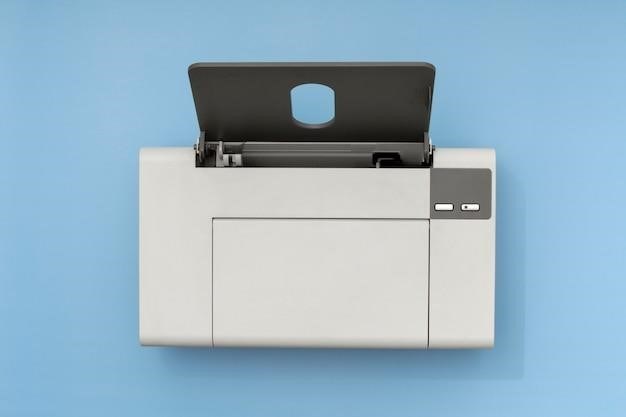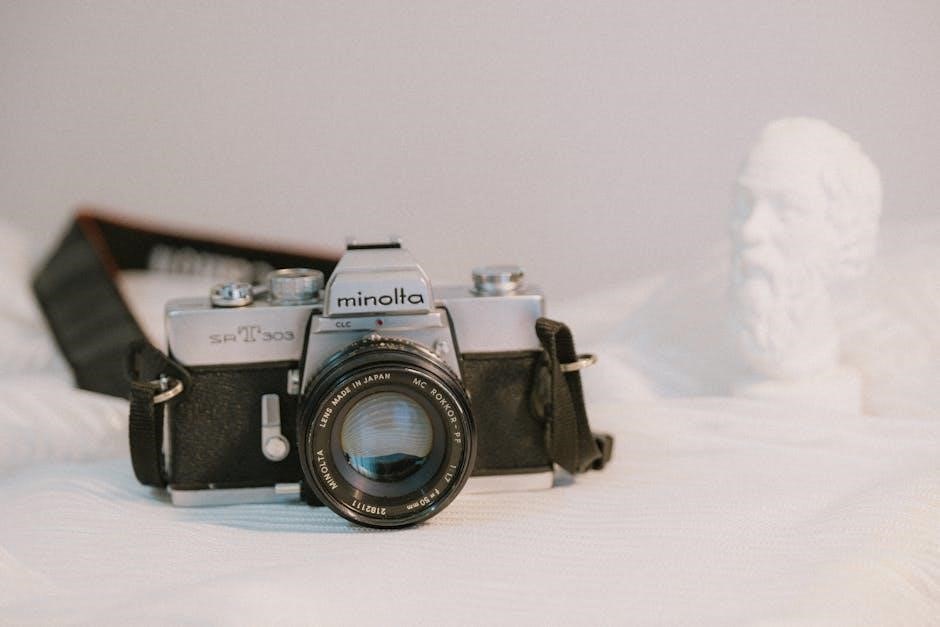bridgeport manual
Bridgeport mills represent a cornerstone of manual machining, offering precision and versatility for hobbyists and professionals alike․ These machines are renowned for their robust construction․
What is a Bridgeport Mill?
A Bridgeport mill, in its manual form, is a versatile power-driven machine tool used to precisely remove material from a workpiece․ It’s fundamentally a metal-cutting machine, though it can work with plastics, wood, and other materials․
The defining characteristic is its knee-and-column design, providing rigidity and allowing movement along three primary axes: X, Y, and Z․ Operators manually control these axes using handwheels, offering direct tactile feedback and precise positioning․
Unlike CNC mills, a Bridgeport manual mill requires skilled operators to interpret blueprints and execute machining operations․ It’s a workhorse for creating custom parts, prototypes, and tooling, valued for its adaptability and relatively simple operation compared to automated systems․
Historical Significance & Evolution
The Bridgeport milling machine’s history began in 1936, born from a need for affordable, precise machining․ Initially designed as a simpler, more accessible alternative to larger, more complex mills, it quickly gained popularity during World War II for tooling production․
Post-war, the Bridgeport became a staple in American machine shops and educational institutions․ Its manual operation fostered a generation of skilled machinists․ Over decades, while CNC technology advanced, the manual Bridgeport remained relevant․
Minor design refinements improved rigidity and ease of use, but the core knee-and-column structure endured․ Today, it’s celebrated for its reliability and remains a valuable tool for small-scale production, repair work, and teaching fundamental machining principles․

Key Components of a Bridgeport Mill
Essential parts include the robust knee and column, precise spindle, versatile table, and overarm, all working together for accurate manual metal removal․
The Knee and Column Assembly
The knee is the heart of vertical travel, supporting the entire milling head and table․ It slides vertically along the column, dictating the Z-axis movement, crucial for controlling cutting depth․ Constructed from cast iron, the knee provides substantial rigidity, minimizing vibration during operation․
The column, a massive vertical structure, houses the spindle and provides mounting points for the overarm․ Its robust design ensures stability and accurately guides the knee’s movement․ Often featuring dovetail ways, the knee-to-column interface guarantees smooth, precise travel․ Proper lubrication of these ways is paramount for maintaining accuracy and extending the machine’s lifespan․ Regular inspection for wear is also vital․
The Spindle and Quill
The spindle is the rotating component that holds the cutting tool․ In a Bridgeport manual mill, it’s typically driven by a belt system connected to a motor, allowing for variable speed control․ Spindle speed selection is critical for matching the cutting tool to the workpiece material and desired finish․

The quill is a sliding sleeve within the milling head that houses the spindle․ It enables precise vertical movement of the cutting tool – the Y-axis – for controlling the depth of cut․ The quill is often manually operated via a handwheel, offering fine control․ Maintaining proper quill bearing adjustment is essential for smooth operation and minimizing runout, ensuring accurate machining results․
The Table and its Movements
The Bridgeport table is a central feature, providing a stable platform for securing workpieces․ It facilitates movement along three axes: X, Y, and Z․ Manual Bridgeport mills achieve this through handwheels directly connected to lead screws․
X-axis movement (left to right) and Y-axis (front to back) are controlled by handwheels on the front of the machine․ The Z-axis, vertical movement, is primarily managed by the quill, but the entire table can also be raised and lowered․ Precise control of these axes is achieved through the fine graduation markings on the handwheels, allowing for accurate positioning of the workpiece relative to the cutting tool․ Table travel dimensions define the maximum workpiece size․

Understanding Bridgeport Mill Controls
Manual Bridgeport controls rely on direct mechanical linkages and levers, demanding operator skill for precise adjustments of speed, feed, and power transmission․
Power Feed Engagement & Disengagement
Engaging the power feed on a manual Bridgeport mill automates table movement along the X, Y, and Z axes, significantly easing the burden during prolonged machining operations․ Typically, a lever system controls each axis’s power feed, allowing independent activation or deactivation․
Disengagement is equally crucial, enabling precise manual control for positioning, fine adjustments, and intricate cuts․ Always fully disengage the power feed before attempting manual movement to prevent damage to the machine’s mechanisms or the workpiece․ A clear ‘click’ often indicates complete disengagement․ Remember to double-check before initiating any manual feed – safety first!
Understanding the proper sequence – engage for efficient material removal, disengage for precision – is fundamental to successful Bridgeport operation․
Speed and Feed Rate Selection
Selecting appropriate speed and feed rates is paramount for optimal cutting performance and tool life on a manual Bridgeport mill․ Spindle speed, controlled by belt changes or a variable drive, dictates cutter rotation․ Feed rate, managed via the power feed engagement, determines table travel speed․
Generally, harder materials require slower speeds and feed rates, while softer materials allow for faster settings․ Larger diameter cutters necessitate slower speeds․ Incorrect settings lead to poor surface finish, tool breakage, or workpiece damage․ Charts and experience guide these choices․
Start conservatively, listening to the machine and observing chip formation․ Adjust incrementally for best results, prioritizing a smooth, consistent cut․
The Overarm and its Functions
The Bridgeport mill’s overarm is a crucial component, providing rigidity and mounting points for essential accessories․ It extends horizontally from the column, supporting the spindle head and offering a stable platform for the coolant system and power feed mechanisms․
Its primary function is to counteract cutting forces, preventing spindle deflection and ensuring accurate machining․ The overarm’s height is adjustable, allowing for optimal positioning of these accessories relative to the workpiece․ It also facilitates easy tool changes and setup․
Proper overarm adjustment is vital for maintaining machine accuracy and preventing vibration․ Regularly inspect its mounting bolts for tightness․

Common Bridgeport Mill Operations
Manual Bridgeport mills excel at diverse tasks like facing, slotting, and pocketing․ Skilled operators achieve precision through careful hand control and technique․
Face Milling

Face milling on a manual Bridgeport involves utilizing a large-diameter cutter to create a flat, smooth surface on a workpiece․ This operation is fundamental for establishing a primary datum plane or achieving a desired final surface finish․ The process demands careful setup, ensuring the workpiece is securely clamped and the cutter is properly aligned with the desired milling area․
Operators manually control the table’s movements – typically X and Y axes – guiding the workpiece under the rotating cutter․ Consistent feed rates and depth of cut are crucial for achieving a uniform surface․ Multiple passes may be necessary, gradually removing material to reach the final dimension․ Attention to cutter geometry and material properties is vital for optimal results and tool life․ Proper coolant application is also essential for heat dissipation and chip evacuation․
Slotting
Slotting with a manual Bridgeport mill is a common operation for creating grooves, channels, or recesses in a workpiece․ Typically performed with end mills, slotting requires precise control of the table’s X and Y axis movements to maintain the desired slot width and depth․ The operator carefully feeds the workpiece into the rotating cutter, monitoring the cutting process for chatter or excessive load․
Multiple passes are often employed, especially for wider or deeper slots, to avoid overloading the mill and ensure a clean cut․ Climb milling versus conventional milling techniques are selectable based on material and desired finish․ Proper workholding is paramount to prevent workpiece movement during the cutting process․ Coolant is essential for lubrication and chip removal, contributing to a higher-quality slot․
Pocketing
Pocketing on a manual Bridgeport mill involves removing material from within a defined area to create a cavity or pocket․ This is typically achieved using end mills, with the operator skillfully maneuvering the table in a controlled pattern – often a zigzag or spiral – to progressively clear the material․ Careful consideration of cutter diameter and stepover is crucial for efficient material removal and a smooth pocket finish․
Maintaining a consistent feed rate and depth of cut is vital to avoid chatter and ensure accuracy․ Climb milling is frequently preferred for pocketing, but conventional milling can also be used depending on the material and setup․ Proper workholding is essential to prevent workpiece movement, and coolant application is necessary for lubrication and chip evacuation․

Tooling for Bridgeport Mills
Essential tooling for a manual Bridgeport includes end mills, collets, chucks, and robust workholding devices, enabling diverse machining operations with precision and reliability․
End Mills: Types and Applications
End mills are fundamental to Bridgeport manual milling, available in various types for specific tasks․ Square end mills excel at general-purpose milling and slotting, while ball nose end mills are ideal for contouring and 3D work․
Center-cutting end mills can plunge directly into material, unlike peripheral-cutting types needing a ramp-in․ Coated end mills, like those with titanium nitride, enhance hardness and lifespan․
Choosing the correct end mill depends on the material being machined – high-speed steel (HSS) for softer materials, and carbide for harder alloys․ Proper flute count impacts chip evacuation; more flutes for finishing, fewer for roughing․ Understanding these nuances maximizes efficiency and achieves superior surface finishes on your Bridgeport․
Collets and Collet Chucks
Collets and collet chucks are essential workholding components for Bridgeport manual mills, providing precise and rigid tool clamping․ Bridgeport mills commonly utilize ER collets, known for their accuracy and versatility․ These collets come in various sizes to accommodate different tool shank diameters․
Collet chucks, mounted to the spindle, securely hold the collet, and consequently, the cutting tool․ Proper collet selection is crucial; using an incorrect size damages both the collet and the tool․
Runout, or the deviation from true concentricity, must be minimized for optimal milling results․ Regularly inspect collets for wear and damage, replacing them as needed to maintain precision and prevent tool breakage during manual operations․
Workholding Solutions: Vises, Clamps, and Rotary Tables
Secure workholding is paramount for successful Bridgeport manual milling; Standard milling vises, with their hardened jaws, are frequently used to clamp rectangular workpieces․ Parallel clamps and strap clamps offer alternative solutions for irregularly shaped parts, ensuring even pressure distribution․
For angular or circular features, a rotary table becomes invaluable․ These tables allow for precise indexing and machining of curved surfaces․ Proper workholding prevents vibration and chatter, improving surface finish and accuracy․
Always ensure workpieces are firmly secured before initiating any cutting operation․ Using appropriate workholding minimizes the risk of workpiece ejection and potential damage to the machine or operator․

Maintenance and Troubleshooting
Regular upkeep is crucial for Bridgeport manual mills․ Consistent lubrication, diligent cleaning, and prompt attention to issues ensure longevity and optimal performance․
Lubrication Procedures
Proper lubrication is paramount for a Bridgeport manual mill’s smooth operation and extended lifespan․ Begin by regularly oiling the ways – both knee and column – using a dedicated way oil․ This minimizes friction and prevents wear․ The spindle bearings require frequent greasing, typically with a lithium-based grease, following the manufacturer’s recommendations․
Don’t neglect the leadscrews and ballscrews; these benefit from a specialized lubricant to maintain accuracy․ Check the lubrication levels in the automatic lubrication system (if equipped) and replenish as needed․ Regularly wipe down all surfaces to remove debris before applying lubricant․ A consistent lubrication schedule, documented in a maintenance log, will significantly reduce downtime and costly repairs․ Always refer to the Bridgeport mill’s specific manual for detailed lubrication instructions․
Common Problems and Solutions
Bridgeport manual mills, while durable, can experience issues․ A common problem is a lack of power to the spindle, often due to a tripped breaker or faulty wiring – check electrical connections first․ Excessive backlash can stem from worn leadscrews or gibs; adjust or replace as needed․ If the knee is difficult to raise or lower, investigate way oil levels and potential binding․
Unusual noises often indicate bearing problems within the spindle or elsewhere․ Overheating can result from insufficient lubrication or excessive cutting speeds․ Always consult the machine’s manual for troubleshooting guidance․ Remember to disconnect power before attempting any repairs and prioritize safety․ If unsure, seek assistance from a qualified machinist or technician․
Preventative Maintenance Schedule
Bridgeport manual mill longevity relies on a consistent maintenance schedule․ Daily, wipe down the machine with a clean cloth and check way oil levels, replenishing as needed․ Weekly, inspect gibs for proper tightness and lubricate all moving parts – leadscrews, dovetails, and spindle bearings․
Monthly, thoroughly clean the coolant system, checking for debris and maintaining proper coolant concentration․ Quarterly, inspect and tighten all fasteners, and check the spindle runout․ Annually, perform a deep lubrication of all bearings and gears, and consider a professional inspection․ Regular maintenance prevents costly repairs and ensures optimal performance․

Safety Considerations
Bridgeport manual mills demand respect; always wear safety glasses, secure long hair, and avoid loose clothing․ Understand emergency stops and machine operation fully․
Personal Protective Equipment (PPE)
When operating a Bridgeport manual milling machine, prioritizing personal safety is paramount․ At a minimum, always wear safety glasses or a face shield to protect your eyes from flying chips and coolant․ Sturdy, closed-toe shoes are essential to guard against dropped materials and potential foot injuries․
Hearing protection, such as earplugs or earmuffs, is highly recommended due to the machine’s noise levels during operation․ Appropriate work gloves can improve grip and offer some protection, but avoid gloves that could become entangled in rotating parts․
Clothing should be snug-fitting, avoiding loose sleeves, drawstrings, or anything that could get caught in the machine․ Tie back long hair to prevent entanglement․ A shop apron can protect your clothing from coolant and chips․ Remember, PPE is your first line of defense against potential hazards․
Emergency Stop Procedures
In the event of an emergency with a Bridgeport manual mill, immediate action is crucial․ The most readily accessible safety feature is the large, red emergency stop (E-Stop) button, typically located on the machine’s control panel․ Pressing this button instantly cuts power to the spindle and coolant pump, halting all machine functions․
Familiarize yourself with the E-Stop’s location before beginning any operation․ If the E-Stop is activated, investigate the cause of the emergency before resetting the machine․ Do not attempt to override or bypass the E-Stop system․
Additionally, know the location of the main power disconnect switch for the mill․ In situations where the E-Stop fails, this provides a secondary means of completely shutting down the machine․ Regular drills practicing emergency shutdown procedures are highly recommended․
Safe Operating Practices
Operating a Bridgeport manual mill safely demands strict adherence to established procedures․ Always secure workpieces firmly using appropriate vises or clamps, preventing movement during machining․ Never reach over or around a rotating cutter; utilize stops and handles for adjustments․
Maintain a clean and organized workspace, free from obstructions․ Wear approved safety glasses at all times, and consider a face shield for operations generating chips․ Avoid loose clothing or jewelry that could become entangled in moving parts․
Before starting any cut, double-check your setup and feed rates․ Never leave the machine unattended while running․ Regularly inspect tooling for wear or damage, and replace as needed․ Prioritize a deliberate and controlled approach to every operation․

Advanced Techniques & Modifications
Bridgeport manual mills can be significantly enhanced through upgrades like DROs and CNC conversions, expanding capabilities and precision for complex machining tasks․
Digital Readout (DRO) Installation
Installing a Digital Readout (DRO) on a Bridgeport manual mill dramatically improves accuracy and efficiency․ A DRO system replaces the traditional dial indicators with digital displays, providing precise positional information for each axis – X, Y, and Z․
The installation process typically involves mounting linear scales to the machine’s ways and connecting them to the DRO control unit․ Careful alignment of these scales is crucial for accurate readings․ Wiring the scales and control unit requires some electrical knowledge, and proper grounding is essential․
Once installed and calibrated, a DRO allows operators to quickly and easily set tool offsets, measure workpiece dimensions, and achieve greater repeatability in their machining operations․ It’s a popular and impactful upgrade for any Bridgeport manual mill․
CNC Conversions
Converting a Bridgeport manual mill to CNC opens up a world of automated machining possibilities․ This involves replacing the manual controls with a CNC control system, stepper motors, and servo drives․ Kits are readily available, simplifying the process, though significant mechanical and electrical expertise is required;
The conversion typically includes installing new X, Y, and Z axis drives, a CNC controller, and often, an encoder on the spindle; Software is then loaded to control the machine’s movements based on G-code programs․ Careful calibration and tuning are vital for optimal performance․
While a substantial undertaking, a CNC-converted Bridgeport offers increased precision, repeatability, and the ability to run complex machining operations unattended, significantly boosting productivity․
Using a Dividing Head
A dividing head, when mounted on a Bridgeport manual mill, enables the machining of rotary workpieces with precise angular spacing․ This is crucial for creating features like gears, splines, or equally spaced holes around a cylindrical part․
The dividing head utilizes a series of change gears to achieve specific ratios, allowing the workpiece to be indexed in very small increments․ Calculating the correct gear train for a desired division is essential, often involving simple ratio calculations․
Proper setup includes securely mounting the workpiece and ensuring the dividing head is accurately aligned with the milling cutter․ Mastering the use of a dividing head expands the Bridgeport’s capabilities beyond basic linear machining․


















































